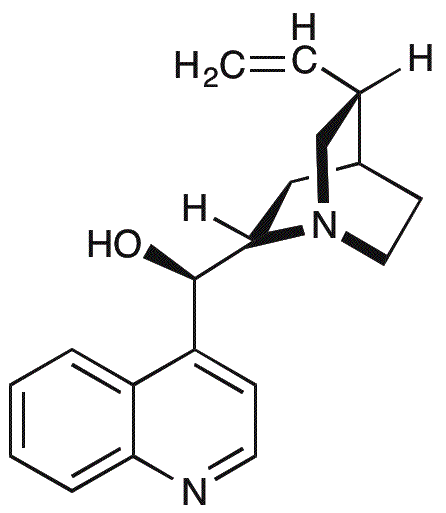Cinchonidine is widely utilized in research focused on:
- Pharmaceutical Development: It serves as a key intermediate in the synthesis of various alkaloids and pharmaceuticals, particularly in the development of anti-malarial drugs.
- Chiral Catalysis: This compound is employed as a chiral ligand in asymmetric synthesis, enhancing the production of enantiomerically pure compounds, which is crucial in the pharmaceutical industry.
- Analytical Chemistry: Cinchonidine is used in chromatography as a chiral stationary phase, allowing for the separation and analysis of enantiomers in complex mixtures.
- Natural Product Synthesis: It plays a significant role in the synthesis of complex natural products, aiding researchers in the study of bioactive compounds derived from natural sources.
- Research in Neuroscience: Its properties are investigated for potential applications in neuropharmacology, particularly in understanding its effects on neurotransmitter systems.
Informations générales
Propriétés
Sécurité et réglementation
Applications
Cinchonidine is widely utilized in research focused on:
- Pharmaceutical Development: It serves as a key intermediate in the synthesis of various alkaloids and pharmaceuticals, particularly in the development of anti-malarial drugs.
- Chiral Catalysis: This compound is employed as a chiral ligand in asymmetric synthesis, enhancing the production of enantiomerically pure compounds, which is crucial in the pharmaceutical industry.
- Analytical Chemistry: Cinchonidine is used in chromatography as a chiral stationary phase, allowing for the separation and analysis of enantiomers in complex mixtures.
- Natural Product Synthesis: It plays a significant role in the synthesis of complex natural products, aiding researchers in the study of bioactive compounds derived from natural sources.
- Research in Neuroscience: Its properties are investigated for potential applications in neuropharmacology, particularly in understanding its effects on neurotransmitter systems.
Documents
Fiches de données de sécurité (FDS)
La FDS fournit des informations de sécurité complètes sur la manipulation, le stockage et l’élimination du produit.
Spécifications du produit (PS)
Le PS fournit une description complète des propriétés du produit, notamment sa composition chimique, son état physique, sa pureté et les exigences de stockage. Il détaille également les plages de qualité acceptables et les applications prévues du produit.
Certificats d'analyse (COA)
Recherchez des certificats d'analyse (COA) en saisissant le numéro de lot du produit. Les numéros de lot et de lot se trouvent sur l'étiquette d'un produit, après les mots « Lot » ou « Lot de fabrication ».
Numéro de catalogue
Numéro de lot/série
Certificats d'origine (COO)
Ce certificat d'exploitation confirme le pays dans lequel le produit a été fabriqué, et détaille également les matériaux et composants utilisés et s'il est issu de sources naturelles, synthétiques ou autres sources spécifiques. Ce certificat peut être requis pour les douanes, le commerce et la conformité réglementaire.
Numéro de catalogue
Numéro de lot/série
Fiches de données de sécurité (FDS)
La FDS fournit des informations de sécurité complètes sur la manipulation, le stockage et l’élimination du produit.
DownloadSpécifications du produit (PS)
Le PS fournit une description complète des propriétés du produit, notamment sa composition chimique, son état physique, sa pureté et les exigences de stockage. Il détaille également les plages de qualité acceptables et les applications prévues du produit.
DownloadCertificats d'analyse (COA)
Recherchez des certificats d'analyse (COA) en saisissant le numéro de lot du produit. Les numéros de lot et de lot se trouvent sur l'étiquette d'un produit, après les mots « Lot » ou « Lot de fabrication ».
Numéro de catalogue
Numéro de lot/série
Certificats d'origine (COO)
Ce certificat d'exploitation confirme le pays dans lequel le produit a été fabriqué, et détaille également les matériaux et composants utilisés et s'il est issu de sources naturelles, synthétiques ou autres sources spécifiques. Ce certificat peut être requis pour les douanes, le commerce et la conformité réglementaire.


